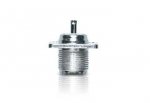Michiganrailfan
Member
Correct me if I'm wrong, but is this the forum to ask questions about software options for Softrock Ensemble? I assume it is, so here's the question:
As I look at the more expensive SDR hardware (Perseus etc), they all come with what appears to the newcomer as much more sophisticated software than Softrock......I like the sophistication, as on You Tube I see examples of users "tuning in" to different peaks, applying filters, widening or narrowing the range of frequencies around the central peak, and so on. What a blast. But it seems to do all that I need to blow at least $500.
On the other hand, I read that, with the right antenna and sound card, Softrock with Rocky -- although a low cost system -- performs just fine.
You're probably all aware that Softrock relies on a sound card to get the IQ data into the PC. Do you thin this limits the bandwidth too much (remember I'm a newcomer....I might not need the high degree of sophistication of other systems costing $500 plus?
As an absolute newcomer to this area (I used to play with my Dad's SWR as a kid....a tube model and great fun), I think I'll pull the trigger and get Softrock Ensemble II with Rocky 3.6 and give it a whirl. If I get addicted, I might move toward the more costly "non soundcard limiting" systems.
It's nice having a group of experts lead me through this. I've learned a great deal reading your posts. Thank You.
As I look at the more expensive SDR hardware (Perseus etc), they all come with what appears to the newcomer as much more sophisticated software than Softrock......I like the sophistication, as on You Tube I see examples of users "tuning in" to different peaks, applying filters, widening or narrowing the range of frequencies around the central peak, and so on. What a blast. But it seems to do all that I need to blow at least $500.
On the other hand, I read that, with the right antenna and sound card, Softrock with Rocky -- although a low cost system -- performs just fine.
You're probably all aware that Softrock relies on a sound card to get the IQ data into the PC. Do you thin this limits the bandwidth too much (remember I'm a newcomer....I might not need the high degree of sophistication of other systems costing $500 plus?
As an absolute newcomer to this area (I used to play with my Dad's SWR as a kid....a tube model and great fun), I think I'll pull the trigger and get Softrock Ensemble II with Rocky 3.6 and give it a whirl. If I get addicted, I might move toward the more costly "non soundcard limiting" systems.
It's nice having a group of experts lead me through this. I've learned a great deal reading your posts. Thank You.


